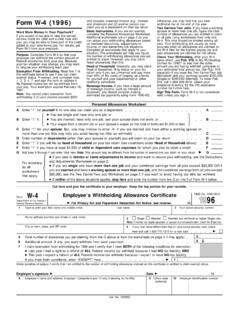Transcription of Employer HDHP and HSA Funding Guide - …
1 Employer hdhp and HSA Funding Guide Purpose: This form reviews a variety of alternatives for Funding high deductible health insurance plans (HDHPs) and Health Savings Accounts (HSAs). Please consult with your tax counsel for assistance in implementing your plan. 2013 HSA Authority, LLC Employer Funding Guide 11/18/2013 Funding of Insurance Premiums Many employers have elected to share the cost burden of health insurance with their employees. The Employer paid portion of insurance premiums is generally deductible by the Employer as an employee benefit but, without a cafeteria plan, the employee portion of the insurance cost will have to be paid with after-tax income.
2 Adding a Section 125 Premium Only Plan (POP). A Premium Only Plan (POP) is a simple, low cost method that allows employees to make insurance payments via pre-tax payroll deferrals. Employer Benefit: employers save payroll taxes on the amounts paid by the employees, typically of the amounts paid plus state unemployment taxes (where applicable). Employee Benefit: Employee insurance payments through a POP are tax-free, resulting in a savings of roughly 15% to 32% in income taxes (depending on the employee s tax rate) plus for payroll taxes (FICA/FUTA).
3 Funding of Health Savings Accounts employers offering High Deductible Health Insurance Plans (HDHPs) also face the choice of whether and how to help their employees with the Funding of the employees Health Savings Account (HSA). The options include: Option 1 - Employee Funded, After-Tax on Employee s Own employers are not required to help with the employees HSAs and may choose not to. In this case, employees may open HSAs on their own and receive the tax deduction on their personal income tax return resulting in savings of about 15-32% depending upon the tax bracket (there is no savings of FICA/FUTA).
4 See the Tax Savings Worksheet to calculate tax savings. This option could include after-tax payroll deferral into an HSA (basically direct deposit to an HSA) Option 2 - Employee Funded, Pre-Tax Through Payroll Deferral employers can help employees fund their HSAs by allowing for HSA contributions via payroll deferral. This is inexpensive and can be accomplished by adding Section 125 plan with an HSA module. The administration is limited because the HSA custodian generally does much of the work. Employer Benefit: employers benefit by not having to pay payroll taxes on the employee s HSA contributions, typically of the amounts paid plus state unemployment taxes (where applicable).
5 Employee Benefit: Employees save on payroll taxes on HSA contributions made through this method (FICA and FUTA are not withheld). Plus, the HSA contribution is also never counted as income, saving approximately 15-32% on income taxes (depending upon state and federal tax brackets and personal income). Note: HSA contributions made outside of payroll are deductible on personal tax returns. Option 3 - Employer Contributions to an HSA employers may make direct contributions to their employees HSAs without a Section 125 plan however, the contributions must be comparable in order to be tax deductible (see our Comparability Worksheet for details).
6 Employer Benefit: Employer HSA contributions are tax deductible by the Employer as an employee benefit. Employee Benefit: Employees receive HSA funds tax-free. Option 4 - Employer and Employee Pre-tax HSA Contributions through Payroll Deferral employers can combine options 2 and 3 (adding a Section 125 POP with an HSA module) allowing themselves and their employees to make tax-free HSA contributions. employers may contribute some money to the HSAs and the employee can add more through payroll deferral (see our Contribution Worksheet for contribution limits).
7 Achieving further tax savings -- add a Limited Purpose FSA or HRA to an HSA To maximize tax benefits for health care expenses, employers can add a limited purpose Flexible Spending Account (FSA) or Healthcare Reimbursement Account (HRA) to an HSA. Generally, FSAs and HRAs are not allowed with HSAs, however, an exception exists for limited purpose plans (plans that are limited to payments for preventive care, vision and dental care). This provides more tax savings for employees that need money for dental or vision.
8 Note: Special rules apply for sole proprietors, partners and most LLC members and shareholders owning more than 2% of an S-corporation. See our Small Business Owners Guide for more detail. We do not provide tax or legal advice. Examples CorporationWithout POPWith POPWith POP & HSAWith POP, HSA & FSAP ayroll500,000$500,000$500,000$500,000 Pre-Tax Payroll Deductions Insurance Premiums- (24,000) (24, ) (24, ) HSA Contributions- - (15, ) (15, ) FSA Contributions- - - (10, ) Total- (24,000) (39, ) (49, )
9 Taxable Payroll500,000$476,000$461,000$451,000 Payroll Taxes 38,25036,41435,26734,502 Payroll Tax Savings$1,836$2,984$3,749 EmployeeWithout POPWith POPWith POP & HSAWith POP, HSA & FSAA nnual Salary50,00050,00050,00050,000 Pre-tax payroll contributions Insurance premiums2,4002,4002,400 HSA Contributions1,5001,500 FSA Contributions1,000 Total pre-tax contributions02,4003,9004,900 Taxable Income50,00047,60046,10045,100 After Tax Costs Insurance(2,400) Medical Expenses(1,500)(1,500) Prevent, Vision, Dental(1,000)(1,000)(1,000)Estimated Taxes ( )(15,325)(14,589)(14,130)(13,823)Net Pay - After Expenses29,77530,51130,97031,277 Savings 7361,1951,5021 Estimated average tax rates of: 20% Federal, FICA and 3% StateABC Corp employs 10 people at an annual payroll cost of $500,000.
10 ABC offers an hdhp with an annual premium of $4,800 per person and offers to pay 50% of the cost of the insurance with employees paying the other 50% of the cost. Subsequent columns assume that the Employer has modified the Section 125 plan to allow for employee HSA contributions of $1,500 and limited purpose FSA contributions of $1, , an employee of ABC corp, has an annual salary of $50,000. He is single individual with no exemptions. This example is illustrating his payment for half the insurance premium ($4,800/2 = $2,400) and estimating that he would spend $1,500 on medical related expenses and $1,000 on preventative care, vision and dental expenses.




